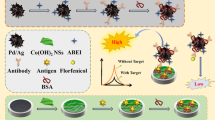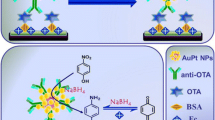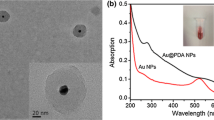Abstract
Tetrabromobisphenol A (TBBPA) is a kind of brominated flame retardant that is usually added to products to reduce their flame retardancy. However, its extensive use has resulted in their residues being found in the environment, which is very harmful. Herein, an indirect competitive immunosensor has been established for TBBPA detection based on the signal amplification system. Pd nanospheres in situ reduced on the surface of MnO2 nanosheet hybrid (MnO2/Pd) was used as the label for the secondary antibody through the Pd-N bond, and gold-toluidine blue composite was loaded onto MWCNTs (MWCNTs/Au-TB), which functioned as the platform for the immunosensor. The spherical structure of Pd had abundant catalytic active sites, which enhanced the catalytic activity of MnO2/Pd as the label, hence amplifying the signal response. Besides, MWCNTs/Au-TB improved electron transfer and produced a strong signaling pathway for immobilizing antigens through the Au-NH2 bond, which can specifically recognize primary antibodies to improve sensitivity. The immunosensor had a linear concentration range of 0–81 ng/mL, a low detection limit of 0.17 ng/mL (S/N = 3), with good stability, selectivity, and reproducibility based on the above advantages. Additionally, the acceptable accuracy and recoveries (recoveries, 92–124%; CV, 3.3–8.8%) in the real water sample analysis indicated that this strategy is promising for emerging pollutant analysis.
Graphical abstract






Similar content being viewed by others
References
Zhu Y, Chao J, Zhu F, Zhu N, Zhang Q, Gyimah E, et al. Ratiometric fluorescence immunoassay based on FAM-DNA–functionalized CdSe/ZnS QDs for the sensitive detection of tetrabromobisphenol A in foodstuff and the environment. Anal Bioanal Chem. 2020;412(15):3605–13.
Gao W, Tian Y, Liu H, Cai Y, Liu A, Yu YL, et al. Ultrasensitive determination of tetrabromobisphenol A by covalent organic framework based solid phase microextraction coupled with constant flow desorption ionization mass spectrometry. Anal Chem. 2019;91(1):772–5.
Liu L, Liu A, Zhang Q, Shi J, He B, Yun Z, et al. Determination of tetrabromobisphenol-A/S and their main derivatives in water samples by high performance liquid chromatography coupled with inductively coupled plasma tandem mass spectrometry. J Chromatogr A. 2017;1497:81–6.
Huang M, Li J, Xiao Z, Shi Z. Tetrabromobisphenol A and hexabromocyclododecane isomers in breast milk from the general population in Beijing, China: contamination levels, temporal trends, nursing infant’s daily intake, and risk assessment. Chemosphere. 2020;244:125524.
Li J, Chen T, Wang Y, Shi Z, Zhou X, Sun Z, et al. Simple and fast analysis of tetrabromobisphenol A, hexabromocyclododecane isomers, and polybrominated diphenyl ethers in serum using solid-phase extraction or QuEChERS extraction followed by tandem mass spectrometry coupled to HPLC and GC. J Sep Sci. 2017;40(3):709–16.
Tay JH, Sellström U, Papadopoulou E, Padilla-Sánchez JA, Haug LS, de Wit CA. Serum concentrations of legacy and emerging halogenated flame retardants in a Norwegian cohort: relationship to external exposure. Environ Res. 2019;178:108731.
Wu M, Wang X, Shan J, Zhou H, Shi Y, Li M, et al. Sensitive and selective electrochemical sensor based on molecularly imprinted polypyrrole hybrid nanocomposites for tetrabromobisphenol A detection. Anal Lett. 2019;52(16):2506–23.
Liu H, Gao W, Tian Y, Wang Y, Liu A, Zhang J, et al. Thermal decomposition tandem mass spectrometry for rapid detection of tetrabromobisphenol A bis (allyl ether) in soils. Talanta. 2019;200:373–7.
Zhang Z, Zhu N, Dong S, Huang M, Yang L, Wu X, et al. Plasmonic ELISA based on nanospherical brush-induced signal amplification for the ultrasensitive naked-eye simultaneous detection of the typical tetrabromobisphenol A derivative and byproduct. J Agric Food Chem. 2017;66(11):2996–3002.
Zeng K, Zhang X, Gyimah E, Bu Y, Meng H, Zhang Z. Chemiluminescence imaging immunoassay for simultaneous Determination of TBBPA-DHEE and TBBPA-MHEE in aquatic environments. Anal Bioanal Chem. 2020:1–9.
Feng J, Tao Y, Shen X, Jin H, Zhou T, Zhou Y, et al. Highly sensitive and selective fluorescent sensor for tetrabromobisphenol-A in electronic waste samples using molecularly imprinted polymer coated quantum dots. Michrochem J. 2019;144:93–101.
Zeng L, Cui H, Chao J, Huang K, Wang X, Zhou Y, et al. Colorimetric determination of tetrabromobisphenol A based on enzyme-mimicking activity and molecular recognition of metal-organic framework-based molecularly imprinted polymers. Microchim Acta. 2020;187(2):142.
Prasad KS, Cao X, Gao N, Jin Q, Sanjay ST, Henao-Pabon G, et al. A low-cost nanomaterial-based electrochemical immunosensor on paper for high-sensitivity early detection of pancreatic cancer. Sens Actuat B-Chem. 2020;305:127516.
Zhang H, Miller BL, Miller. Immunosensor-based label-free and multiplex detection of influenza viruses: state of the art. Biosens Bioelectron. 2019;141:111476.
Wang Y, Liu G, Hou X, Huang Y, Li C, Wu K. Assembling gold nanorods on a poly-cysteine modified glassy carbon electrode strongly enhance the electrochemical reponse to tetrabromobisphenol A. Microchim Acta. 2016;183(2):689–96.
Zhao Q, Zhang K, Yu G, Wu W, Wei X, Lu Q. Facile electrochemical determination of tetrabromobisphenol A based on modified glassy carbon electrode. Talanta. 2016;151:209–16.
Pei F, Wang P, Ma E, Yang Q, Yu H, Gao C, et al. A sandwich-type electrochemical immunosensor based on RhPt NDs/NH2-GS and Au NPs/PPy NS for quantitative detection hepatitis B surface antigen. Bioelectrochemistry. 2019;126:92–8.
Dong S, Wang S, Gyimah E, Zhu N, Wang K, Wu X, et al. A novel electrochemical immunosensor based on catalase functionalized AuNPs-loaded self-assembled polymer nanospheres for ultrasensitive detection of tetrabromobisphenol A bis(2-hydroxyethyl) ether. Anal Chim Acta. 2019;1048:50–7.
Sun C, Mu Y, Wang Y. A Pd/MnO2 electrocatalyst for nitrogen reduction to ammonia under ambient conditions. Catalysts. 2020;10(7):802.
Yan J, Li X, Jin B, Zeng M, Peng R. Synthesis of TiO2/Pd and TiO2/PdO hollow spheres and their visible light photocatalytic activity. Int J Photoenergy. 2020;2020:1–9.
Fedorenko G, Oleksenko L, Maksymovych N, Skolyar G, Ripko O. Semiconductor gas sensors based on Pd/SnO2 nanomaterials for methane detection in air. Nanoscale Res Lett. 2017;12(1):329.
Spezzati G, Benavidez AD, DeLaRiva AT, Su Y, Hofmann JP, Asahina S, et al. CO oxidation by Pd supported on CeO2(100) and CeO2(111) facets. Appl Catal B-Environ. 2019;243:36–46.
Ma E, Wang P, Yang Q, Yu H, Pei F, Zheng Y, et al. Electrochemical immunosensors for sensitive detection of neuron-specific enolase based on small-size trimetallic au@Pd^Pt nanocubes functionalized on ultrathin MnO2 nanosheets as signal labels. ACS Biomater-Sci Eng. 2020;6(3):1418–27.
El-Wekil MM, Darweesh M, Shaykoon MSA, Ali R. Enzyme-free and label-free strategy for electrochemical oxaliplatin aptasensing by using rGO/MWCNTs loaded with AuPd nanoparticles as signal probes and electro-catalytic enhancers. Talanta. 2020;217:121084.
Lu F, Zhang S, Zheng L. Dispersion of multi-walled carbon nanotubes (MWCNTs) by ionic liquid-based phosphonium surfactants in aqueous solution. J Mol Liq. 2012;173:42–6.
Xu S, Zhang R, Zhao W, Zhu Y, Wei W, Liu X, et al. Self-assembled polymeric nanoparticles film stabilizing gold nanoparticles as a versatile platform for ultrasensitive detection of carcino-embryonic antigen. Biosens Bioelectron. 2017;92:570–6.
M. Pallares R, Stilson T, Choo P, Hu J, Odom TW. Using Good’s buffers to control the anisotropic structure and optical properties of spiky gold nanoparticles for refractive index sensing. ACS Appl Nano Mater, 2019. 2(8): p. 5266–5271.
Ma J, Chen G, Bai W, Zheng J. Amplified electrochemical hydrogen peroxide sensing based on Cu-porphyrin metal organic framework nanofilm and G-quadruplex-hemin DNAzyme. ACS Appl Mater Inter, 2020.
Zhang L, Ying Y, Li Y, Fu Y. Integration and synergy in protein-nanomaterial hybrids for biosensing: strategies and in-field detection applications. Biosens Bioelectron. 2020;154:112036.
Wang X, Sun M, Guo Y, Hu J, Zhu M. Three dimensional Pt island-on-Au architectures coupled with graphite carbon nitride nanosheets for effective photo-accelerated methanol electro-oxidation. J Colloid Interface Sci. 2020;558:38–46.
Siddiqui S, Shawuti S. Sirajuddin, Niazi JH, Qureshi A. l-Cysteine-mediated self-assembled Ag–Au nanoparticles as fractal patterns with bowling-alley-like hollow arrays for electrochemical sensing of dopamine. Ind Eng Chem Res. 2019;58(19):8035–43.
Kitching H, Kenyon AJ, Parkin IP. The interaction of gold and silver nanoparticles with a range of anionic and cationic dyes. Phys Chem Chem Phys. 2014;16(13):6050–9.
Liang R, Chen Y, Qiu J. A sensitive amperometric immunosensor for hepatitis B surface antigen based on biocompatible redox-active chitosan–toluidine blue/gold nanoparticles composite film. Anal Methods. 2011;3(6):1338.
Bastús NG, Comenge J, Puntes V. Kinetically controlled seeded growth synthesis of citrate-stabilized gold nanoparticles of up to 200 nm: size focusing versus Ostwald ripening. Langmuir. 2011;27(17):11098–105.
Wei C, Yu L, Cui C, Lin J, Wei C, Mathews N, et al. Ultrathin MnO 2 nanoflakes as efficient catalysts for oxygen reduction reaction. Chem Commun. 2014;50(58):7885–8.
Yang Y, Duan H, Xia S, Lü C. Construction of a thermo-responsive copolymer-stabilized Fe 3 O 4@ CD@ PdNP hybrid and its application in catalytic reduction. Polym Chem. 2020;11(6):1177–87.
Hanifah MFR, Jaafar J, Othman MHD, Yusof N, Rahman MA, Salleh WNW, et al. One-step fabrication of a highly dispersed palladium nanoparticle-decorated reduced graphene oxide electrocatalyst for methanol electro-oxidation in acidic media. J Phys Chem Solids. 2021;148:109718.
Bredar AR, Chown AL, Burton AR, Farnum BH. Electrochemical impedance spectroscopy of metal oxide electrodes for energy applications. ACS Appl Ener Mater. 2020;3(1):66–98.
Wu S, Fan S, Tan S, Wang J, Li C-P. A new strategy for the sensitive electrochemical determination of nitrophenol isomers using β-cyclodextrin derivative-functionalized silicon carbide. RSC Adv. 2018;8(2):775–84.
Eng ML, Williams TD, Fernie KJ, Renier NKK, Henry PF, Letcher RJ, et al. In ovo exposure to brominated flame retardants. Part I: Assessment of effects of TBBPA-BDBPE on survival, morphometric and physiological endpoints in zebra finches. Ecotox Environ Safe. 2019;179:179.
Funding
The present work was supported by the 13th five-year development plan of China by the National Key Research and Development Program (2017YFC1600301), the National Natural Science Foundation of China (Grants 21876067, 21577051), and the Jiangsu Collaborative Innovation Center of Technology and Material of Water Treatment.
Author information
Authors and Affiliations
Contributions
Salome Yakubu: conceptualization, methodology, software, writing—original draft. Boyuan Jia: writing—reviewing. Yujia Guo: data curation. Yanmin Zou: investigation, validation, funding acquisition, supervision. Kunlong Liang: visualization, writing—original draft. Jiaxuan Xiao: investigation, validation. Yuanqing Bu: visualization, software. Ninghui Song: funding acquisition, investigation. Zhen Zhang: writing—reviewing and editing.
Corresponding author
Ethics declarations
Conflict of interest
The authors declare no competing interests.
Additional information
Publisher’s note
Springer Nature remains neutral with regard to jurisdictional claims in published maps and institutional affiliations.
Supplementary information
ESM 1
(PDF 785 kb)
Rights and permissions
About this article
Cite this article
Yakubu, S., Jia, B., Guo, Y. et al. Indirect competitive-structured electrochemical immunosensor for tetrabromobisphenol A sensing using CTAB-MnO2 nanosheet hybrid as a label for signal amplification. Anal Bioanal Chem 413, 4217–4226 (2021). https://doi.org/10.1007/s00216-021-03368-7
Received:
Accepted:
Published:
Issue Date:
DOI: https://doi.org/10.1007/s00216-021-03368-7




